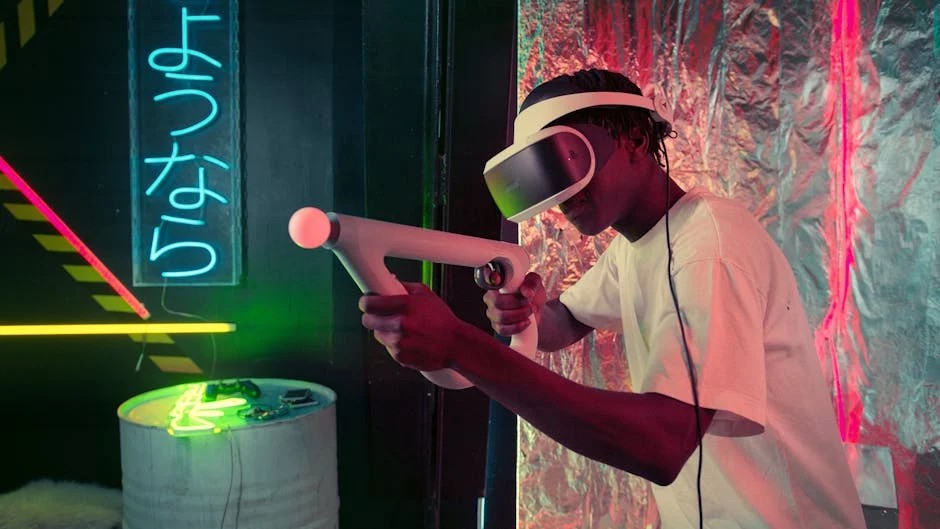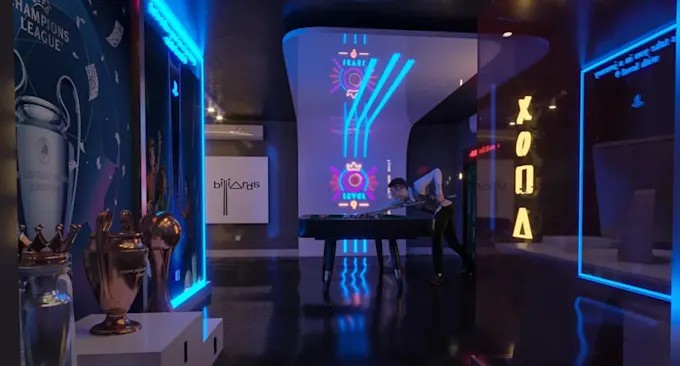The Digital Overlay: How Augmented Reality is Reshaping the Gaming Landscape
For decades, the world of Video Games has been defined by the glowing rectangle of a screen. Whether on a massive Gaming Monitor connected to a high-end Gaming PC, a television hooked up to the latest console, or the vibrant display of a smartphone, our digital adventures have been confined to a window. But a new frontier is rapidly expanding, one that seeks to shatter that window and spill digital content directly into our physical world. This is the realm of Augmented Reality, or AR Gaming, a technology poised to fundamentally change our relationship with interactive entertainment. Unlike its cousin, VR Gaming, which transports you to an entirely new digital world, AR enriches and enhances the one you already inhabit.
This technological shift is more than just a novelty; it represents a paradigm change in Game Design and player interaction. It’s a world where a strategic map for an RPG Game can be projected onto your coffee table, where digital monsters from a Battle Royale can hide behind real-world trees in your local park, and where the history of a city block can come to life as you walk through it. This article provides a comprehensive technical breakdown of the world of AR Gaming, exploring the core technologies that power it, the current state of the market, the unique challenges in Game Development, and the exciting future that awaits as hardware and software evolve.
The Foundations of AR Gaming: Technology and Key Concepts
At its core, AR Gaming is a complex dance between sophisticated software and advanced hardware, all working in concert to create a believable and interactive digital overlay. Understanding these foundational pillars is crucial to appreciating both its current limitations and its immense potential. From the algorithms that map your room to the engines that render the graphics, this is the technology that makes the magic happen.
SLAM: The Eyes of Augmented Reality
The single most important technology enabling modern AR is SLAM, which stands for Simultaneous Localization and Mapping. In simple terms, SLAM is the process that allows a device, like your smartphone or a pair of AR glasses, to build a map of an unknown environment while simultaneously keeping track of its own location within that map. Using data from cameras and motion sensors (like accelerometers and gyroscopes), SLAM algorithms identify unique feature points in the environment—the corner of a desk, the pattern on a rug, the edge of a picture frame—and use them as anchors. This allows for two critical AR functions:
- Plane Detection: Identifying flat surfaces like floors, walls, and tabletops where digital objects can be placed.
- World Tracking: Ensuring that once a digital object is placed, it stays “locked” to its position in the real world, even as you move around it. This is what allows you to walk around a digital character as if it were truly in the room with you.
Hardware: From Smartphones to Smart Glasses
The accessibility of AR Gaming today is largely thanks to the powerful devices we already carry. The current Gaming Hardware landscape is dominated by:
- Mobile Devices: Modern smartphones and tablets are the primary platform for Mobile Gaming in AR. Platform-specific software development kits (SDKs) like Google’s ARCore and Apple’s ARKit provide developers with the tools to leverage the device’s camera, CPU, GPU, and motion sensors to create rich AR experiences. The ubiquity of these devices has made them the perfect entry point for the mass market.
- Dedicated AR Headsets: While still largely in the enterprise or enthusiast space, devices like the Microsoft HoloLens 2 and Magic Leap 2 represent the future of AR. They offer a hands-free experience with a wider Field of View (FOV) and more advanced sensor suites than phones. As this technology becomes smaller, cheaper, and more powerful—a constant topic in Gaming Tech circles—we will see a shift from “holding a window” to truly “wearing a world.”
The Software Stack: Engines and SDKs

Building an AR game from scratch is a monumental task. Thankfully, the leading game engines have embraced the technology, making it more accessible for developers of all sizes, from Indie Games studios to AAA powerhouses. The latest Unity News and Unreal Engine News frequently highlight new features and optimizations for AR development. These engines integrate ARKit and ARCore functionalities directly, providing developers with a unified workflow to build experiences that can be deployed across both iOS and Android. This allows them to focus more on the creative aspects of Game Design and less on the low-level computer vision problems that SLAM solves.
The AR Gaming Landscape: From Niche Hits to AAA Potential
While the technology is impressive, it’s the games themselves that will determine the success of the medium. The AR gaming landscape has evolved significantly from simple tech demos to globally recognized phenomena, showcasing a variety of gameplay mechanics and pointing toward a future of deeper, more integrated experiences that could one day be a staple of the Gaming Industry.
The Trailblazers: Pokémon GO and Ingress
No discussion of AR Gaming is complete without mentioning Niantic’s Pokémon GO. Released in 2016, it was a watershed moment, demonstrating the massive commercial and cultural potential of location-based AR. The game’s success wasn’t just due to its beloved IP; it was a masterclass in leveraging AR to encourage real-world exploration, social interaction, and community building. Players weren’t just tapping on a screen; they were organizing group raids, exploring new parts of their cities, and sharing their experiences. This blend of digital play and physical activity created a powerful gameplay loop that captivated millions and remains a benchmark for the genre. Its predecessor, Ingress, laid the groundwork, proving that a dedicated Gaming Community could be built around a location-based sci-fi narrative.
Evolving Gameplay: Beyond Location-Based Catching
While Pokémon GO defined the first wave, developers are now exploring a wider range of AR mechanics. We are seeing innovation across multiple genres:
- Tabletop Strategy: Games like Resolution Games’ Demeo are experimenting with AR modes that project a virtual game board onto a real table, blending the social feel of a board game night with the dynamic visuals of a video game. This could revolutionize Strategy Games.
- First-Person Shooters: FPS Games in AR turn your home or backyard into a battlefield. Titles like The Walking Dead: Our World have you fighting off zombie hordes that appear to be shambling down your actual street, a concept that could be expanded upon by major franchises often featured in Call of Duty News or Apex Legends News.
- Puzzle and Exploration: AR is a perfect fit for puzzle games that require players to physically inspect and manipulate virtual objects from different angles, or for educational games that overlay historical information onto real-world landmarks, transforming a city tour into an interactive quest reminiscent of a classic RPG Game.
The Indie and AAA Divide
Currently, the Mobile Gaming AR space is a hotbed of innovation for Indie Games developers. The low cost of entry (no need to manufacture physical media or compete for shelf space) and the established development pipelines in Unity and Unreal Engine make it an attractive platform for experimentation. In contrast, major AAA Games publishers have been more hesitant. The challenges of designing a blockbuster experience that works reliably in millions of uncontrolled, diverse real-world environments are significant. However, as dedicated AR hardware matures, we can expect to see major franchises from the worlds of PlayStation News and Xbox News make bigger, more ambitious entries into the space.
Designing for a Blended Reality: Challenges and Best Practices
Creating a compelling AR game is not as simple as placing a 3D model in a camera feed. It requires a fundamental rethinking of Game Design principles. Developers must account for a variable, unpredictable, and deeply personal playspace: the player’s own world. Navigating this new design paradigm is fraught with challenges, but a clear set of best practices is beginning to emerge.

Common Pitfalls in AR Development
Many early AR titles stumbled by falling into predictable traps. A key pitfall is the “gimmick” trap, where AR is used as a superficial feature rather than a core gameplay mechanic. Simply allowing a player to view a character model in their room is a novelty that wears off quickly. A successful AR game must use the real world in a meaningful way. Another major challenge is environmental inconsistency. A game designed for a spacious, well-lit living room may be unplayable in a cramped, dimly lit bedroom. Developers must design for flexibility or clearly communicate the optimal playing conditions. Finally, user safety and privacy are paramount. Games that encourage players to walk around while focused on a screen must incorporate safety warnings and design that minimizes risk. The data collected from a player’s environment also raises significant privacy questions that the Gaming Industry must address responsibly.
Best Practices for Engaging AR Experiences
To overcome these challenges, successful AR Game Development focuses on several key principles:
- Contextual Awareness: The best AR games make the experience feel magical by having the digital content react intelligently to the real world. A virtual pet that avoids real furniture or a puzzle that incorporates the colors of a player’s walls creates a powerful sense of presence.
- Intuitive User Interface (UI): UI design is incredibly difficult when the background is the player’s cluttered, ever-changing environment. Best practices involve using high-contrast, minimalist interfaces that anchor to the player’s view or to specific real-world surfaces, ensuring legibility without overwhelming the scene.
- Seamless Onboarding: Teaching players how to physically move to play a game is a new challenge. Effective onboarding guides users through the process of scanning their environment and understanding the physical interactions required, ensuring a comfortable and intuitive first-time experience. This is crucial for expanding beyond the core Gaming Community.
The Future Horizon: Where AR Gaming is Headed
The current state of AR Gaming is just the prologue. The convergence of several key technologies promises a future where the line between the physical and digital blurs even further, creating persistent, shared realities that could rival the scale of today’s biggest MMORPG News headlines.

The Hardware Revolution and Cloud Integration
The next five to ten years will be defined by a revolution in Gaming Hardware. The goal is the “AR Grand Challenge”: creating lightweight, stylish, all-day wearable glasses with a wide FOV, long battery life, and immense processing power. As advancements in mobile Graphics Cards and processors continue, these devices will become a reality. However, the ultimate endgame may not rely on local processing alone. The rise of Cloud Gaming and Game Streaming services, powered by 5G technology, will be a game-changer. By offloading the heavy rendering and AI calculations to powerful servers in the cloud, future AR glasses can remain slim and efficient. This technology will enable a persistent, shared AR layer over the world—sometimes called the “AR Cloud” or “Mirrorworld”—where changes made by one player are instantly visible to all others, creating a true global-scale augmented reality experience.
Cross-Platform and Social Integration
The future of gaming is connected. We will see deeper integration between traditional Console Gaming, PC Gaming, and AR. Imagine getting a Fortnite News update and being able to preview the new season’s battle pass skins as full-sized 3D models in your room. Consider a companion app for a new game announced in PlayStation News that lets you use your phone to find hidden clues in the real world that unlock content in the main console game. This cross-pollination of platforms will make AR an integral part of the broader gaming ecosystem, not just a separate category. It will enhance everything from Competitive Gaming and Esports News, where fans could see real-time stats overlaid on a live match, to the creative world of Game Mods, where users build and share their own AR experiences.
Conclusion: A New Dimension of Play
Augmented Reality gaming has moved far beyond the realm of science fiction and simple tech demos. Built on a sophisticated technological foundation of SLAM, powerful mobile hardware, and accessible game engines, it has already proven its ability to create compelling, world-spanning experiences. While significant design and technical challenges remain, the path forward is clear. The convergence of next-generation AR glasses, the low-latency power of 5G, and the immense potential of Cloud Gaming will unlock a new era of interactive entertainment. AR is not here to replace traditional gaming but to augment it, offering a new dimension of play that integrates our digital lives more deeply with the physical world. The glowing rectangle of the screen will no longer be a window we look through, but a door we step through into a newly enchanted reality.












